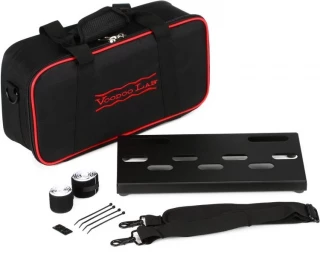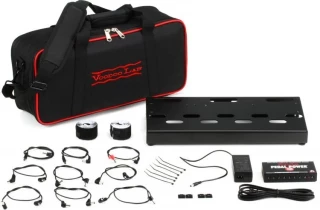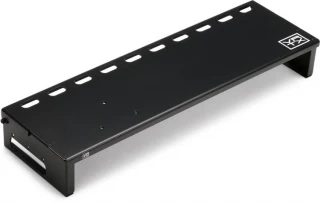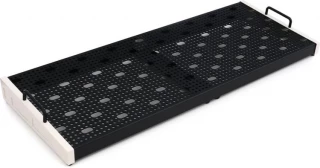TRIO 28 Templeboard - Temple Red Review
Featured Deal
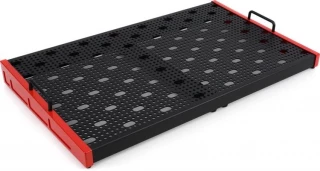
From $144.00
Get DealTRIO 28 Templeboard - Temple Red
28" Modular Pedalboard System for 3 Rows of FX - Temple Red
$149.00
$104.30
$134.10
TRIO 28 Templeboard - Temple Red For Sale
Most Popular Pedalboards
Dingbat Pedalboard - Tiny 14.5" x 6.5"
14.5" x 6.5" Pedalboard with Aircraft-grade Aluminum Chassis, Hook-and-loop Mounting Tape, UV-resistant... read more
Dingbat Pedalboard Power Package - Small with Pedal Power X8
Aluminum Pedalboard, 18-inches x 7.75-inches, with Pedal Power X8 Power Supply, and... read more
TC1 Hinged Pedalboard Riser - 26 inches x 8 inches
Hinged Aluminum Pedalboard Riser - Black Powder Coated read more
Travel Plus Pedalboard - Version Two, 20-inch x 11.5-inch
Aluminum Pedalboard with Updated Buffer/Power Module Slotting read more
DUO 34 Templeboard - Vintage White
34" Modular Pedalboard System for 2 Rows of FX - Vintage White read more
Specifications |
|||
|---|---|---|---|
| Brand | Temple Audio | ||
| Category | Pedalboards | ||
| Height: | 1.5" (front), 2.5" (back), | ||
| Length: | 28.2", | ||
| Depth: | 16.5", | ||
| Weight: | 4.8 lbs., | ||
| Material: | Lightweight Aluminum board, | ||
| Manufacturer Part Number: | TRIO-28-TR, | ||
Daily Deals
TRIO 28 Templeboard - Temple Red Reviews
Best pedalboard for the money or more
This is a well thought out pedalboard and incorporates the best of all fastening devices. The separately sold mounts (connectors) are a far superior to velcro and cable ties, although you can still easily use both if you want. The mounts use a screw underneath and fit neatly into existing holes and like some other boards with holes, there are enough to place pedals where you want.… read more They tighten by finger but a guitar pick is good for the final tightening. The mounts adhere to the underside of the pedal and my guess is they will be hard to pull off but they eliminate the need for feet and eliminate velcro adhesive and it's sticky remnants. There are also numerous ways to attach the power supply, in my case under the board and using a combination of the TA mount and 2 cable ties as my supply is heavy. Most other supplies will hold using the mounts. There are also many options for running the power cable(s), xlr, or midi, whatever you choose. The handles on top are perfect for grab and go. I've used other popular high rated boards, this one is the most flexible, lightest, and intelligent of them. And, looks cool too.
Nice for neat freaks like me.
It could be a thicker gauge and feel a little sturdier, but I love the method of attaching pedals. The method I use to attach the medium plates is to attach a little tape to two sides of the plate and have them extend out to the sides, place the plate where it will be on the board and lined up to be in the middle of the pedal, set the pedal where it will be positioned and pull the… read more ends of the tape up and to the sides of the pedal, remove plate and pedal together. Draw a reference line across the top of the plate on the back of the pedal, remove it and the tape and remove the backing and use the line to place the plate permanently on the pedal. Works great to get pedal exactly aligned along the front edge of the board. Product and design.
Great Board!
Easily configured, solid, and attractive. Eliminates messy velcro setup.
Temple Audio TRIO 28 Templeboard
Very smart idea with (Temple Audio Quick Release Pedal Plates). I highly recommend this Templeboard. Also thank you for my Sweetwater Sales Engineer David Snyder.
Still not the perfect solution but, pretty good
There are drawbacks to just about every type of pedalboard. The old tried and true velcro route is still the most popular but, it starts to get pretty ugly with age and heavier pedals sometimes don't stay on too well. The solutions that use zip ties are sometimes OK but, the pedal usually doesn't stay super tight and the geometry of some pedals make the zip ties difficult to wrap… read more around it. So, after a lot of looking and reading reviews, I decided to try a Templeboard. After using it for only a few days, I'm pretty happy with it but, there are some caveats that you may want to be aware of. First, the good points. It's pretty versatile. You can place the pedals pretty much anywhere you want. The only restriction is the you need to leave the larger holes open if you want to take advantage of hiding the cable routes under the board. If you don't care about that, and just want to leave the cables on top you have even more freedom of placement. I have a few non-standard and oversize pedals so, being able to place them pretty much anywhere made this product more attractive to me than a Pedaltrain. The Temple Audio website has a planner page with hundreds of pedals that you can use to help figure out what size board you need. I definitely recommend playing around with that if you are going to buy a Templeboard. I was originally going to buy a smaller one but, after using the online planner, I realized I needed a Trio 28. It's also fairly sturdy. I was concerned about the board flexing since the surface is perforated sheet metal, especially on board with a large surface area. But, it's a pretty thick gauge steel, and when you add the stabilizer (sold separately) there's very little give, and that's only in the center. I would recommend placing pedals that you're going to be riding a lot, like a wah, near the right or left edge where there's no flex at all. Doesn't have the structural integrity of a Pedaltrain, which you could almost run over with a tour bus without killing it. I don't know how well it would hold up for someone who tours a lot but, for a home studio player like me, it's tougher than I need it to be. Adding some of the optional modules to the side panels make the board even slicker but, it drives the price up. I feel like some of those modules are quite overpriced (especially the switched AC power inlet) but they're all form fitted to go neatly into the side panels so, if you want it to look all cool and professional, you just gotta bite the bullet. If you're less concerned about that you can always just take the panel blank out of the side and just run a power cord through that hole to your power supply. Speaking of power supplies, keep in mind that the mounting plates work on both sides of the board. Temple makes a power supply bracket but, it's only compatible with VooDoo power supplies. I have a Truetone CS12 but was able to mount it easily to the underside of the board using two large size mounting plates. I used some shallow head screws I got from the hardware store instead of the thumbscrews for the power supply so that pedals on the other side could clear the screws. You're kinda limited in what size power supply will fit under the board. Sweetwater lists the dimensions of the board as 2.5" in the back but that's the outer dimension. My PS is two inches tall and just barely fits. If it were just slightly larger it wouldn't fit underneath. Now for the aforementioned caveats. One of the complaints I've heard more than once about this product is that the board is made of "cheap metal" and that it's easy to strip the threads when you're trying to mount the modules in the side panels. Since I had already heard about this going in, I was quite cautious when installing these parts. The problem is not the hardness of the metal. It's that the screws are really small diameter, really short, and have very fine threads. You have to be really careful when you thread them in. If you get one of the screws crossthreaded, it's all over. You'd have to then drill a hole all the way through and use a different screw with a nut on the back. (I personally think they should have just used through-holes to begin with) Added to this, one of the screws for the power inlet near the back of the board is a blind hole, and you can't see if it's going in straight. I found it easier to just remove the entire side panel so I could see what I was doing. The screws may not look like they're going to be long enough at first but, be aware that the threaded insets pressed into the side panel stick out a little bit and are designed to go into a countersunk hole on the module. Also, because the screws are so tiny, you have to be really careful not to overtighten them. The board comes with a long, screwdriver with a thin handle that doesn't allow for a lot of torque. I highly recommend using the tool that is provided, rather than reaching for your favorite phillips head, to prevent damaging the screws or the inserts. Once you get the modules installed, the board is ready for pedals. Obviously you have to take the feet off of your pedals, which is the case with most pedalboard solutions. But be aware the adhesive plates are pretty thin. If your pedals have no screws on the bottom, or of the screws are countersunk, then it's a breeze. But if, like me, you have some pedals that use pan-head screws on the bottom that don't sit flush, then they will likely be slightly higher then the surface of the mounting plate, making it a little more difficult to place onto the board. I also have a pedal where the bottom surface of the pedal is slightly recessed into the housing. This type of pedal is also difficult to use with the Temple system. I didn't have any pedal that I wasn't able to mount on the board but, some that had the problems I mentioned above were difficult to get the shallow pegs on the mounting plates locked into the board. So, those pedals are now putting extra tension on the adhesive because the thumbscrew on the mounting plate is pulling the surface of the board up a little bit to meet with the plate. Only time will tell if this constant tension will eventually pull the adhesive plate off of the pedal. So four and a half out of five stars but, that's a pretty high score, since as I mentioned at the beginning of this review, no pedal solution comes without pains. I would recommend this board to anyone who's looking for something different than a traditional pedalboard.
TRIO 28 Templeboard - Temple Red Questions and Answers
No Questions Yet.






